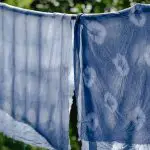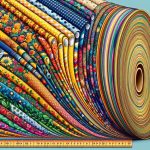Are you wondering how many yards are on a roll of silk fabric? Look no further! This article will provide you with all the information you need.
We’ll break down the factors that affect yardage, give you standard measurements, and teach you how to calculate yardage on a roll.
Plus, we’ll share some tips for estimating yardage and maximizing your purchase.
So, let’s dive in and uncover the secrets of silk fabric yardage!
Table of Contents
Understanding Silk Fabric
You can learn about silk fabric by understanding its properties and how it is made. Silk is a luxurious and highly sought-after fabric known for its softness, smoothness, and natural sheen. It is produced from the cocoons of silkworms, which are then carefully unraveled to obtain the silk fibers. Several factors affect the quality of silk fabric, including the type of silkworm, the diet of the silkworm, and the climate in which the silk is produced. These factors can impact the strength, luster, and texture of the silk.
One of the main benefits of silk fabric is its hypoallergenic properties. Silk is naturally resistant to dust mites, mold, and mildew, making it an excellent choice for individuals with allergies or sensitive skin. Additionally, silk fabric is highly breathable and has temperature-regulating properties, keeping you cool in hot weather and warm in cold weather. It also has a unique ability to absorb moisture, keeping you dry and comfortable throughout the day.
Another advantage of silk fabric is its durability. Despite its delicate appearance, silk is a strong and long-lasting fabric that can withstand regular wear and tear. Its natural protein structure gives it excellent tensile strength, making it a worthwhile investment.
Factors Affecting Yardage on a Roll
There are several factors that can affect the amount of yardage you get on a roll of silk fabric. Yardage variations in silk fabric can occur due to factors like fabric weight, fabric width, and fabric usage.
The weight of the silk fabric can impact the amount of yardage you get on a roll. Heavier silk fabric tends to take up more space, resulting in fewer yards on a roll. On the other hand, lighter silk fabric takes up less space, allowing for more yardage on a roll.
Additionally, the width of the fabric can also affect the yardage. Wider silk fabric generally means more yardage on a roll, while narrower fabric results in less yardage.
Lastly, the fabric usage can impact the yardage as well. If there are any flaws or defects in the fabric, it may require cutting out certain sections, resulting in less overall yardage. Similarly, if the fabric is being used for a specific pattern that requires larger pieces, it may result in less yardage on a roll.
Standard Yardage Measurements for Silk Rolls
When measuring standard yardage for silk rolls, it’s important to consider the weight, width, and usage of the fabric.
Standard yardage measurements are used to determine the length of silk fabric on a roll. The most popular silk fabric lengths range from 9 to 12 yards. These lengths are often used for various purposes, such as making dresses, blouses, or scarves.
The weight of the fabric, measured in ounces per square yard, affects the overall length of the silk roll. Lighter-weight silk fabrics, such as chiffon or organza, usually come in longer lengths, while heavier-weight silk fabrics, like satin or brocade, may have shorter lengths.
The width of the fabric is another important factor to consider. Standard silk rolls generally have a width of 45 inches, but wider options, like 54 or 60 inches, are also available.
It’s essential to measure the fabric accurately and consider the specific requirements of your project to ensure you purchase the appropriate standard yardage for your silk roll.
How to Calculate Yardage on a Roll
When it comes to calculating yardage on a roll, there are various methods you can use. These methods take into consideration several factors that can affect the yardage. These factors include the width of the fabric, the shrinkage rate, and any pattern repeats.
Yardage Calculation Methods
To calculate the yardage of a roll of silk fabric, you can use various methods. Here are some tips for measuring silk fabric:
- Measure the length of the roll from one end to the other using a tape measure.
- Note down the width of the fabric. This will help you determine the total area.
- Divide the total area by 36 to get the yardage. Remember, one yard is equal to 36 inches.
If the width of the fabric is uneven or irregular, measure the widest and narrowest points and calculate an average. Take into account any pattern repeats or extra fabric needed for hemming or finishing.
Factors Affecting Yardage
Factors such as the fabric’s width, pattern repeats, and extra fabric needed for hemming can affect the amount of yardage required for a project. When working with silk fabric, these factors become even more important to consider.
Silk fabric yardage factors include the width of the fabric, which typically ranges from 45 to 60 inches. The wider the fabric, the less yardage you will need. Pattern repeats also play a role, as you may need to match patterns and therefore require more fabric. Additionally, it’s important to account for extra fabric needed for hemming, especially when working with delicate silk.
To estimate yardage for a silk fabric project, you can use yardage estimation techniques such as measuring and calculating based on the pattern repeats and desired hemming allowance. By carefully considering these factors, you can ensure you have enough silk fabric for your project.
Tips for Estimating Yardage on a Silk Roll
If you’re wondering how many yards are on a roll of silk fabric, here are some tips to help you estimate the yardage with accuracy, especially when measuring irregular silk rolls:
-
Measure the length: Start by unrolling the silk fabric and measuring its length from one end to the other. Make sure to stretch it out fully to get an accurate measurement.
-
Calculate the average width: Since silk rolls can have irregular widths, measure the width at multiple points along the roll. Add up the measurements and divide by the number of points to find the average width.
-
Multiply length by width: Multiply the length of the silk fabric by its average width. This will give you an estimate of the total square footage.
-
Convert square footage to yards: Divide the total square footage by 9 to convert it to yards. This will give you an estimate of the yardage on the silk roll.
-
Consider waste and shrinkage: Keep in mind that there might be some waste or shrinkage during the cutting and sewing process. It’s a good idea to add a little extra yardage to account for this.
Common Yardage Options for Silk Fabric
When it comes to silk fabric, it’s important to understand the standard yardage options available. Knowing the popular silk fabric lengths will help you make informed decisions for your projects.
Additionally, being aware of the various silk roll size options will give you flexibility in choosing the right amount of fabric for your needs.
Standard Silk Yardage
To determine the standard yardage of silk fabric on a roll, you can simply measure it yourself. Silk is a luxurious and versatile fabric that is produced from the cocoons of silkworms. Understanding silk production can help you appreciate its value and quality.
Here are some benefits of silk fabric:
- Soft and smooth texture: Silk feels incredibly gentle against your skin, providing a luxurious and comfortable wearing experience.
- Breathable: Silk fabric is highly breathable, allowing air to circulate and keeping you cool in warm weather.
- Moisture-wicking: Silk has the ability to absorb and release moisture, keeping you dry and comfortable.
- Hypoallergenic: Silk is resistant to dust mites and other allergens, making it a great choice for those with allergies or sensitive skin.
- Versatile: Silk fabric can be used for a variety of purposes, including clothing, home decor, and accessories.
Popular Silk Fabric Lengths
To determine the length of popular silk fabrics, you can refer to the industry standards and consult a fabric specialist for accurate information.
When it comes to popular silk fabric lengths, it’s important to consider the specific type of silk you are working with. Different silk fabrics come in varying widths, typically ranging from 36 inches to 54 inches.
The length of the fabric can vary as well, with common options being 1 yard, 3 yards, and 5 yards. However, it’s crucial to note that these are just general estimations and may vary depending on the manufacturer or supplier.
To accurately estimate yardage for your project, it’s always best to consult a fabric specialist who can provide you with the most precise information based on the specific silk fabric you are using.
Silk Roll Size Options
For accurate information on the size options of silk rolls, you can consult a fabric specialist who can provide you with the most precise details based on your specific needs. When it comes to silk roll sizes, there are various options available to choose from.
Here are some common sizes you may come across:
- 45 inches wide by 10 yards long
- 54 inches wide by 5 yards long
- 60 inches wide by 3 yards long
- 36 inches wide by 15 yards long
- 72 inches wide by 2 yards long
These sizes offer flexibility and cater to different project requirements. Whether you are working on a small craft project or a larger garment, you can find a silk roll size that suits your needs.
Buying Silk Fabric by the Yard
You can find out how many yards are on a roll of silk fabric by checking the product description or asking a sales associate.
When purchasing silk fabric by the yard, it is important to consider the pricing and the options available from different manufacturers. Silk fabric pricing can vary depending on factors such as the quality of the silk, the manufacturer, and any additional features or finishes.
It is advisable to compare prices from different manufacturers to ensure that you are getting the best value for your money. Additionally, researching different silk fabric manufacturers can help you make an informed decision about the quality and reputation of the product. Look for manufacturers that have a good track record of producing high-quality silk fabrics and have positive customer reviews.
Maximizing Yardage on a Silk Roll
One way to make the most of your silk roll is by carefully measuring and planning your cuts. By maximizing yardage efficiency and employing creative fabric manipulation techniques, you can optimize the use of your fabric and create stunning garments or projects. Here are some tips to help you achieve this:
-
Straight cuts: Use a rotary cutter or sharp fabric scissors to make clean, straight cuts. This will ensure that you have precise pieces that can be easily sewn together without wasting excess fabric.
-
Pattern layout: Lay your pattern pieces on the fabric in a strategic manner. Arrange them close together, but make sure there is enough space for seam allowances and any necessary pattern matching.
-
Bias cutting: Consider cutting some pieces on the bias. This technique allows for extra stretch and drape in your garments, and can also help you use up smaller scraps of fabric.
-
Piecing: Instead of cutting one large piece for your project, consider piecing smaller sections together. This can create interesting design elements and save you from using unnecessary yardage.
-
Fabric manipulation: Explore different ways to manipulate the fabric to create texture and volume. Techniques like pleating, gathering, and smocking can add visual interest while also using less fabric.
Conclusion
In conclusion, understanding the factors that affect yardage on a roll is essential when it comes to silk fabric. By calculating and estimating yardage accurately, you can make informed decisions when buying silk fabric. These tips can help you make the most of your silk fabric purchase, whether you need a specific yardage or want to maximize the amount you get on a roll.
Remember, knowing the common yardage options available will also assist you in selecting the right amount for your project.
- How Does Ring Spun Cotton Affect Garment Fit and Shape Retention? - August 13, 2024
- What Are the Challenges in Producing Ring Spun Cotton? - August 13, 2024
- Is Ring Spun Cotton Suitable for Plus-Size Clothing? - August 13, 2024






